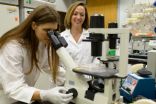(Press-News.org) Bobbing your head, tapping your heel, or clapping along with the music is a natural response for most people, but what about those who can't keep a beat?
Researchers at McGill University and the University of Montreal, have discovered that beat-deafness, though very rare, is a problem not simply of how people feel a pulse or move their bodies, but instead, how people synchronize with sounds they hear.
"We examined beat tracking, the ability to find a regular pulse and move with it, in individuals who complained of difficulty following a beat in everyday activities like listening to music and dancing," says McGill psychology professor Caroline Palmer.
Deficits in synchronizing help to uncover fundamental properties of human neural function, such as how auditory and motor systems are integrated in neural networks.
Because beat deafness is so rare, the researchers compared two beat deaf individuals with 32 control participants of comparable age and educational level. Listeners were asked to tap evenly in the absence of any sound. The researchers found that all participants performed this task well, ruling out a general motor deficit.
"We found that these beat-deaf individuals were able to perceive different rhythms and tap a regular beat in the absence of sound, similarly to control group members," says Palmer. "Only when they had to move with the beat did we see a deficit, compared with the control group."
No sense of rhythm
"Most people had no problem, but the beat-deaf individuals were quite variable in their tapping - sometimes missing the beat by a large amount," says Palmer, who is also Director of the NSERC-CREATE training network in Auditory Cognitive Neuroscience. "The most difficult test was to tap along with a metronome that suddenly became faster or slower. The non-beat-deaf were able to adapt to the changes within a few beats, but interestingly, the beat-deaf individuals were not able to synchronize with the new beat. The types of mistakes that beat-deaf individuals made indicated deficits in biological rhythms, including the natural frequencies or rates at which the internal oscillations pulsed, and how long it took them to respond to the new metronome tempo."
Biological rhythms are behaviors that are periodic or cyclic, and can be slow like circadian day/night cycles or fast like heart rates. Common activities like walking, clapping, making music, and even speaking are all examples of rhythms. Some rhythmic behaviors are driven by external cues, like a musical tempo that makes a jogger run faster, or a fast walker who slows down to match their partner's pace.
"While most people can adapt their rhythms in response to an external cue, some people are less able to do that", says Palmer. "We tested what makes beat-deaf individuals different, by seeing how people whose biological rhythms may not respond normally to external cues adapt to an external beat".
Rare condition
Utilizing computational models to build on their previous work on beat-deafness, the researchers compared how well an internal rhythm, modeled with a periodic (cyclic) oscillator, changes its pulse in response to an external cue from the metronome. This approach enables researchers to determine not only how beat-deaf individuals differ from normal controls, but also how one beat-deaf individual may differ from another. It also enables researchers to build better scientific models of what it means for someone to synchronize their behavior with someone else.
"Our findings support the idea that beat-deafness is a problem of how our internal biological rhythms adapt to or couple with changing sounds in the environment that, in most individuals, make it possible to dance, ice skate with a partner, and bob one's head to the beat of a favorite tune".
INFORMATION:
This research was supported by NSERC, Canada Research Chairs program, and Belgian FRS-FRNS.
Losing the beat: Deficits in temporal coordination by Caroline Palmer, Pascale Lidji, and Isabelle Peretz will be published in the journal Philosophical Transactions: Biological Sciences on November 10, 2014.
BRAMS (International Laboratory for Brain, Music and Sound Research, in Montréal) is looking for people who have difficulties dancing or moving in time with a beat. If you cannot synchronize simple body movements to music or to a beat and would like to participate in our studies, please send us an e-mail at beat.brams@gmail.com
Contact:
Cynthia Lee
cynthia.lee@mcgill.ca
Relations avec les médias | Media Relations
Université McGill | McGill University
T. 514.398.6754
http://www.mcgill.ca/newsroom/
http://twitter.com/#!/McGilluMedia
JACKSONVILLE, Fla. -- All patients with hepatitis C who receive a liver transplant will eventually infect their new livers. These transplanted organs then require anti-viral treatment before they become severely damaged. But traditional post-transplant hepatitis C therapy can take up to a year, is potentially toxic and can lead to organ rejection.
Now, at the American Association for the Study of Liver Diseases (The Liver Meeting® 2014) in Boston, researchers at Mayo Clinic report that use of two new oral medications post-transplant is safe and beneficial, and requires ...
Berlin, Germany (November, 2014) - Sweating, panting, moving to the shade, or taking a dip are all time-honored methods used by animals to cool down. The implicit goal of these adaptations is always to keep the brain from overheating. Now a new study shows that armor-plated dinosaurs (ankylosaurs) had the capacity to modify the temperature of the air they breathed in an exceptional way: by using their long, winding nasal passages as heat transfer devices.
Led by paleontologist Jason Bourke, a team of scientists at Ohio University used CT scans to document the anatomy ...
GAINESVILLE, Fla. -- Noroviruses are pernicious intestinal viruses. They cause violent vomiting and diarrhea, and people ill with the virus remain contagious up to three days after they seem to recover.
Although a vaccine for these viruses is in clinical trials, there is still no medication to combat them. That's in part because researchers have not been able to culture human noroviruses so they can test potential treatments -- until now, according to a study by University of Florida Health researchers published Friday, Nov. 7 in the journal Science.
UF Health researcher ...
In a new, in-depth research project, Queen's professors Rob Siemens (Urology) and Christopher Booth (Cancer Care and Epidemiology) investigated what affect higher volume hospitals and surgeons had on the outcomes of patients undergoing a radical cystectomy for bladder cancer in Ontario.
Using data provided by the Institute for Clinical Evaluative Sciences (ICES) the investigators studied 2,802 patients who underwent the procedure between 1994 and 2008 in Ontario and found that higher volume hospital and surgeons were associated with less post-operative complications and ...
BUFFALO, N.Y. -- Preschoolers whose parents have rules about what their children can and cannot eat have healthier eating habits than those raised without such rules, according to a new study by pediatrics researchers at the University at Buffalo.
The study also provides new information on how toddlers' ability to self-regulate, or control, their emotional and behavioral impulses influences their eating habits two years later, depending on the presence or absence of parental food rules.
The research is being presented on Nov. 7 at ObesityWeek 2014 in Boston. ObesityWeek ...
As if having a heart attack isn't bad enough, cardiologists know that the worst damage may actually occur after it's over.
Blocked arteries are typically the trigger, stopping the flow of blood and starving the heart muscle of oxygen. But when the blockage is removed and the blood comes rushing back, it wreaks havoc of its own. The result is called reperfusion injury, a life-threatening flood of inflammation and cellular destruction that has stumped scientists for 40 years.
Now, however, a potentially groundbreaking study by Fred Hutchinson Cancer Research Center scientists, ...
Seok Kang, associate professor in the UTSA Department of Communication, collaborated with Korean researcher Jaemin Jung to study the smartphone habits of college students in the United States and South Korea. The researchers were particularly interested in the type and amount of information college students from both countries disclose. The study was published in Computers in Human Behavior.
The two countries were selected due to the high rates of smartphone ownership among their young adults. Eighty percent of Americans own smartphones while the ownership rate in Korea ...
Researchers led by Dr. Debra Auguste, associate professor, biomedical engineering, in the Grove School of Engineering at The City College of New York, have identified a molecule that could lead to developing treatment for one of the most aggressive forms of breast cancer.
Triple negative breast cancers (TNBCs) have a high mortality rate owing to aggressive proliferation and metastasis and a lack of effective therapeutic options. However, Professor Auguste's team, discovered the overexpression of intercellular adhesion molecule-1 (ICAM-1) in human TNBC cell lines and tissues, ...
Employers know that dramatic changes in the workplace, such as the start of the "busy season" or a new, more demanding boss, can cause employees to act out in ways that hurt the bottom line. But a new study suggests that companies may be underestimating the impact of such behavior because they assume it only happens immediately after a stressful change.
The research from SF State organizational psychologist Kevin Eschleman shows that many employees wait weeks or months before engaging in "counterproductive work behaviors," like taking a longer lunch or stealing office ...
Two NASA and one European spacecraft, including NASA's MAVEN mission led by the University of Colorado Boulder, have gathered new information about the basic properties of a wayward comet that buzzed by Mars Oct. 19, directly detecting its effects on the Martian atmosphere.
Data from observations carried out by MAVEN, NASA's Mars Reconnaissance Orbiter (MRO) and the European Space Agency's Mars Express spacecraft revealed that debris from the comet, known officially as Comet C/2013 A1 Siding Spring, caused an intense meteor shower and added a new layer of ions, or charged ...




